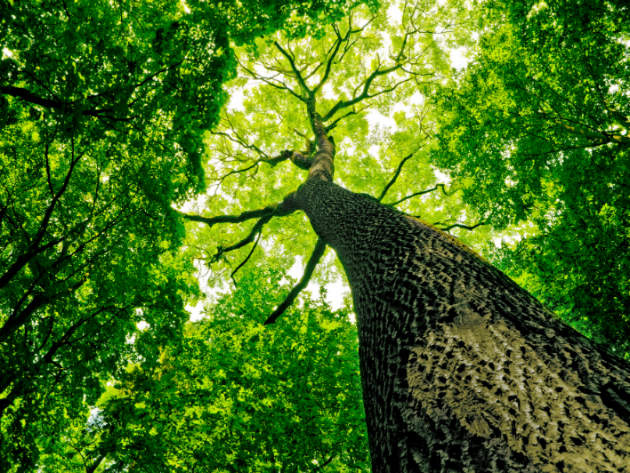

If you took all of the plastic bottles we use around the word in just one year, you could build a tower to the moon 25 times. Perhaps we produce too much fossil-based waste, yet when we try to tackle the issue, we zone-in on the micro-details: can we use 2% less plastic here, 33% less there? Can we get plastic to be recycled one more time? Can we eke out another marginal gain?
Maybe we can, but maybe we’re missing the wood for the trees. Maybe we’re so focused on the narrow details that we miss the big idea because all of these improvements are still based on pulling fossil fuels out of the earth which is not renewable. However what if we could create sustainable quality products and packaging from something that was? Something that helped our environment rather than destroyed it and that grew out of the ground rather than was buried under it?
What if we used wood? Imagine using trees to create a new generation of renewable biomaterials that can build high-rises, planes and cars, completely revolutionising our approach to a sustainable society.
The wonder of wood: creating new biomaterials
Here’s a big claim: everything that’s made with fossil fuels today can be made from a tree tomorrow. I can make that claim because, ultimately, anything you can do with fossil fuel in terms of materials you can do with a tree. By breaking down wood fibres into tiny fibrils, we can rebuild them into new biomaterials.
For example, it’s possible to make stronger, lighter packaging than current options, from nanocellulose and glues and carbon fibre from lignin, a natural polymer found in wood. Both of these are found in the 50% of a tree’s content currently unused by pulp processors, which today are typically burnt for fuel. There’s an abundant supply and a clear business case that can drive the trend towards a bio-based economy, with a backbone made of wood.
Some of the technology to do this is still in research and development, but it’s far from a moonshot. Lignin is already used as a replacement for fossil-based phenols used in furniture and wall panelling; a by-product called fluff can already be used in personal hygiene products and a textile fibre derived from dissolving pulp gives an alternative to cotton.
These fibres are already being used in creative new ways and European Bioplastics, a trade association, predicts that by just 2018, 6.8 million tonnes of bioplastics will be produced globally that are at least partly derived from plants. Admittedly, that’s against the 20 million tonnes of regular plastics currently converted into packaging each year in the EU alone – but it’s still huge growth in a short time frame.
More recyclable, truly renewable: could trees be the answer?
Only 14% of plastic packaging is collected for recycling. That’s a vast amount of waste which, when it is burnt, releases greenhouse gases into the atmosphere. Then, in order to replace it, we pull more fossil fuels from the earth (which has a finite supply). We should always applaud smarter and better recycling facilities, but that underlying model will never be renewable.
Biomaterials are highly recyclable and much more easily reused than petrochemicals. Though claims have been made against the lack of recyclability of on-the-go paper cups produced from virgin fibre, this is a grave misconception. Used packages can be collected and recycled either separately or together with other fibre-based products. Moreover, without a steady supply of virgin fibre there is simply nothing to recycle and renew.
More importantly trees, unlike fossil fuels, are an infinitely replenishable resource. So long as plantations are reforested more quickly than they’re harvested we won’t run out of trees but rather grow the forestland. Trees should not to be viewed as commodities but as the renewable resources they are. For example, in my native Sweden there is twice as much forest today as 100 years ago: the very definition of responsible foresting.
The incredible thing about more trees is that they remove existing carbon dioxide from the atmosphere rather than add to it. The only gas emitted is pure oxygen. So long as the net number of trees increases, the industry can actually sequester more carbon than it produces. Through photosynthesis, a normal tree absorbs an average of one tonne carbon dioxide per cubic metre and continues to store it after products, such as houses, are made from the wood. Architects and city planners are catching on and wooden skyscrapers are on the rise across the globe.
Smart packaging: revolutionising the sector
Biomaterials allow us to take a cleaner approach to packaging, however packaging is set to get smarter as well as greener. Embedded sensors using wireless communications are set to revolutionise the sector, telling us where packages are, what they contain and how fresh those contents are, for example. The data unlocked by using these sensors opens up another whole world of possibilities. More efficient supply chains, better transport systems and less wastage could all contribute to an even more environmentally friendly packaging sector over and above the benefits of biomaterials.
Wood is one of the longest-serving resources used by the human race. It’s easy to think of wood as quaint and old-fashioned. The future we were brought up to imagine was all shiny glass and gleaming metal. But look past all those trees and you’ll see the solution right under our noses, with wood as the renewable answer to a sustainable future.



